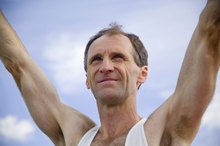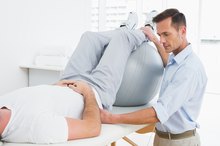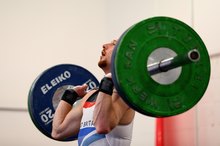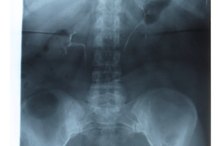Occupational Therapy & Shoulder Rotator Cuff Exercises
Because rotator cuff repairs can be extremely complex, rehabilitation is often extensive, lasting three to six months. To rehabilitate patients, occupational therapists use activities that mirror the demands of the patients' occupations -- unlike physiotherapists, who use exercises as the primary means of rehabilitation. However, occupational therapists will usually implement free weight training programs during the strengthening phase of rehabilitation.
Before engaging in any sort of rehabilitation activities, the first objective of occupational therapy is to assess both the current condition of the shoulder and to analyze its daily demands 1. Only after the assessment is complete can a set of treatment goals be identified, and a program is designed.
Immediate Goals of Rehabilitation
Ulnar Osteotomy Rehabilitation Protocols
Learn More
Once assessment is complete, the initial goals of rehabilitation are to protect the repaired tendon, decrease pain and reduce inflammation in the shoulder. The arm is immobilized in a sling for the first 5 to 6 weeks after surgery, and a regimen of cold therapy and anti-inflammatory drugs is usually instituted.
Passive Range of Motion Exercises
Once inflammation has subsided, the next phase of rehabilitation involves passive range of motion exercises. With these activities, the therapist guides the patient's fingers, wrist, lower and upper arm through a series of stretches to help increase flexibility, prevent stiffness and break up scar tissue. This phase of treatment often includes the use of hot packs, ice and ultrasound therapy.
Active Range of Motion Exercises
Common Rear Shoulder Injuries
Learn More
After patients complete the passive portions of the rehabilitation programs -- which can often last five to six weeks -- they move on to active range of motion exercises. Patients perform these exercises themselves, both under the supervision of the therapist, and on their own time based on regimens outlined by therapists. In addition to basic stretches, these exercises often include shoulder pendulums, elbow flexion/extension movements and basic internal and external rotation movements that are tailored to the demands of the patient's occupation. This portion of rehabilitation does not include strengthening exercises.
- After patients complete the passive portions of the rehabilitation programs -- which can often last five to six weeks -- they move on to active range of motion exercises.
- In addition to basic stretches, these exercises often include shoulder pendulums, elbow flexion/extension movements and basic internal and external rotation movements that are tailored to the demands of the patient's occupation.
Strengthening and Preventative Maintanance
After 12 weeks of rehabilitation, patients normally begin performing exercises to strengthen the shoulder muscles. At this point, most daily activities are allowed to be performed, with the exception of strenuous work or sport activities that would require heavy lifting or quick movements. Strengthening exercises are often performed with dumbbells and/or resistance bands and include internal and external rotation movements: front, lateral and rear raises, and wrist circles. Other resistance exercises are normally designed by therapists to simulate specific job-related movements. This portion of therapy can last a full year, depending upon the nature of the repairs, and ongoing exercises are usually prescribed to prevent recurrences of injuries.
- After 12 weeks of rehabilitation, patients normally begin performing exercises to strengthen the shoulder muscles.
- This portion of therapy can last a full year, depending upon the nature of the repairs, and ongoing exercises are usually prescribed to prevent recurrences of injuries.
Related Articles
References
- Shoulderdoc: Occupational Therapy and the Shoulder; Julie Upton dipCOT SROT; 2011
- MD Guidelines: Rotator Cuff Repair
- Sgroi TA, Cilenti M. Rotator cuff repair: post-operative rehabilitation concepts. Curr Rev Musculoskelet Med. 2018;11(1):86–91. doi:10.1007/s12178-018-9462-7
- American Academy of Orthopaedic Surgeons. Shoulder Surgery Exercise Guide. Updated February 2017.
- Fleming JA, Seitz AL, Ebaugh DD. Exercise protocol for the treatment of rotator cuff impingement syndrome. J Athl Train. 2010;45(5):483–485. doi:10.4085/1062-6050-45.5.483
- Hazar Z, Baltacı G. Effects of ’’Throwers Ten’’ Exercise Program on Pain and Function in Shoulder Impingement Syndrome: A Pilot Study. Orthop J Sports Med. 2014;2(3 Suppl):2325967114S00153. doi:10.1177/2325967114S00153
- Davies G, Riemann BL, Manske R. CURRENT CONCEPTS OF PLYOMETRIC EXERCISE. Int J Sports Phys Ther. 2015;10(6):760–786.
Writer Bio
Christopher Cascio is a memoirist and holds a Master of Fine Arts in creative writing and literature from Southampton Arts at Stony Brook Southampton, and a Bachelor of Arts in English with an emphasis in the rhetoric of fiction from Pennsylvania State University. His literary work has appeared in "The Southampton Review," "Feathertale," "Kalliope" and "The Rose and Thorn Journal."









